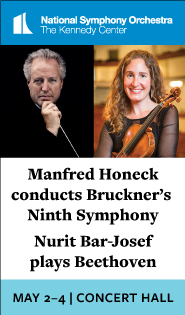Manfred Honeck finds the unexpected in Mozart and Dvořák with NSO

Manfred Honeck made a triumphant return to the podium of the National Symphony Orchestra Thursday night. The Austrian conductor’s last appearance with the NSO, in 2008, fell shortly before he took over as music director of the Pittsburgh Symphony Orchestra. His tenure there has been long and fruitful, lasting at least through the 2021-2022 season.
Listening to this program in the Kennedy Center Concert Hall, it was easy to hear why. With precise gestures and gentle but confident ideas, Honeck helped the NSO musicians shape two somewhat standard pieces, Mozart’s Piano Concerto No. 24 and Dvořák’s Eighth Symphony, into something surprising. The only fly in the ointment was the concert opener, a recent work by Mason Bates.
For this standout Mozart piano concerto, last performed by the NSO in 2005, Honeck had Russian pianist Nikolai Lugansky as his soloist. The combination proved ideal, as pianist and conductor rarely differed in tempo and musical conception. In the first movement, Lugansky followed the lead of the NSO in transparency and lightness, making the first piano entrance placidly, the many runs kept smooth and polished. Artful understatement marked the day.
Mozart, who premiered this concerto as soloist and conductor in 1786, never wrote down the cadenzas he played. Lugansky chose those composed by Johann Nepomuk Hummel, performed with a few of his own modifications. The extensive cadenza of the first movement delighted with virtuosic showmanship, including feathery roulades, close counterpoint, and a final chromatic cascade down the keys. Lugansky hardly broke a sweat.
Honeck fielded about forty string players, perhaps more than a period instrument ensemble might choose but a good match for the large number of brass and woodwind parts Mozart included in this concerto. The second movement felt buoyant and unhurried, with pliant strings alternating with sections for the NSO’s impeccable wind band. Only a stray cell phone ring marred the end, receiving a glare from Honeck over the piano lid.
The finale broadened considerably with more forceful playing from the NSO and the demanding solo part benefitting from Lugansky’s attention to every detail of sound. Honeck and Lugansky had the same conception of musical weight, contrasting with lack of weight on unstressed notes, that animated every phrase. Honeck’s careful balancing of orchestral sound never forced Lugansky’s hand.
A similar dynamic range and flexible pacing enlivened Dvořák’s Eighth Symphony, its calm opening drawn out with longing rubato. Fierce speed fired up the rest of the movement, which drove crisply to an exciting conclusion. The softest moments of the second movement were almost so faint as to be inaudible, a whisper of sound, with tender themes presented by clarinets, flute, and solo violin.
At the same time there was something tragic about Honeck’s conception of this slow movement, forceful more than sentimental, which made it the highlight of the work. The tempo of the third movement never quite settled, with Honeck focused more on the arching lines of the melodic material than the activity gurgling around it. A brilliant trumpet fanfare led off the last movement, with the burnished cello section introducing the movement’s main theme.
Each variation of the theme appealed, from the crazy, spiraling horn call of the fast section, taken at breakneck speed, to the folkloric middle section filled with rustic touches. The double bass section’s turn at the melody lumbered sweetly, leading to a thrilling, tautly rendered conclusion.
The PSO commissioned Mason Bates to compose Resurrexit in honor of Honeck’s 60th birthday in 2018. As heard in its NSO debut, obvious gestures befitting the soundtrack of a slightly hokey movie about Christ’s resurrection abounded. In the opening section, melodic tics like bends and augmented seconds evoked Middle Eastern music.
Muted trumpet, shadowed by glockenspiel, quoted the Easter sequence chant Victimae paschali laudes, a tune that reappeared at the climax with squealing piccolo and glittering percussion. Bates eschewed his normal electronica, introducing instead some exotic percussion to bridge the gap. A little set of bells, like those rung at the altar during a Catholic Mass, and a wooden board, called the semantron and used to summon monks to a procession, added a liturgical hint to this over-perfumed potpourri.
The program will be repeated 11:30 a.m. Friday and 8 p.m. Saturday. kennedy-center.org; 202-467-4600







